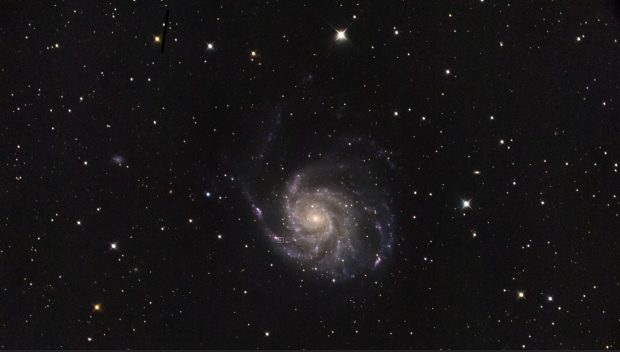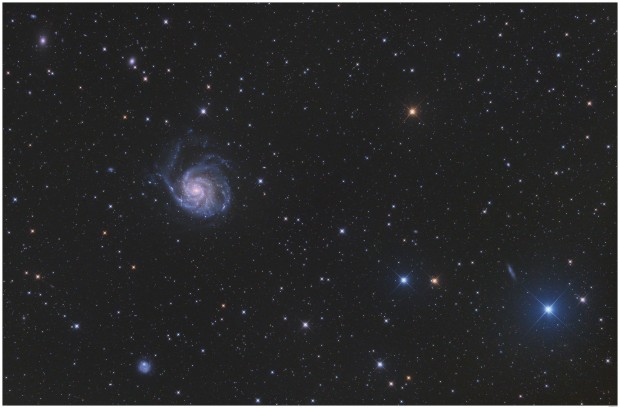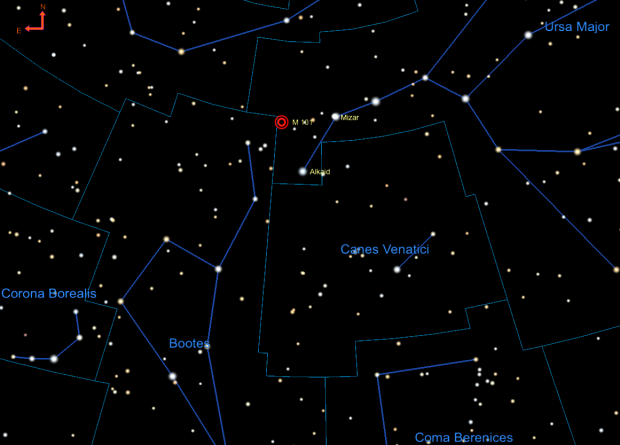Take your small scope out tonight to view the aftermath of a massive star’s death.

The box on this image shows the spot where the bright, new supernova SN 2023ixf has appeared in M101. Credit: [-ChristiaN-] (Flickr)
When a massive star dies, it goes out with a bang, creating a stunningly bright explosion that can temporarily change the look of the night sky. The brightest and closest may be visible with the nɑƙeɗ eye, but even those in distant galaxies can be easily spotted with amateur equipment from your backyard. And now, just such an opportunity has appeared: A supernova just went off in the nearby spiral galaxy M101 (NGC 5457) and you can find it tonight in the sky.
According to NASA, the new supernova, called SN 2023ixf, was first spotted by Koichi Itagaki on May 19. Itagaki discovered the supernova when it was magnitude 14.9, though it quickly brightened over the weekend. After the blast had been identified, astronomers went back through data from the Zwicky Transient Facility and found the first evidence of the supernova two days before that.
Now that it’s appeared, SN 2023ixf is expected to remain visible in a telescope for months, offering an amazing and unique target for your telescope all summer long.

The bright supernova SN 2023ixf (identified with the vertical lines) was recently discovered in spiral galaxy M101. Credit: Dominique Dierick (Flickr)Finding M101 and its supernova
Those of us in the Northern Hemisphere are extra-lucky: M101 is located in the circumpolar constellation Ursa Major, meaning it’s always above the horizon. No matter when your observing session starts, it will be up in the sky for you to find, and you can also start looking for it as soon as darkness falls.

M101 lies in Ursa Major near the last two stars in the Big Dipper’s handle. Credit: Alison Klesman (via TheSkyX)
The galaxy sits near the end of the Big Dipper’s handle, forming the apex of a triangle with the last two stars in the handle, magnitude 2.2 Mizar and magnitude 1.9 Alkaid, as the base. Draw a line between these two stars, stop halfway along, and look about 4.5° northeast. You’ll land right on 8th-magnitude M101, often called the Pinwheel Galaxy because its face-on nature shows off its stunning spiral arms.
M101 stretches about 22′ across and sits just over 20 million light-years away. That’s pretty close, by cosmic standards, which means its supernova should be easy to spot. The bright point of light lies just southwest of NGC 5461, a bright knot of glowing hydrogen gas in the galaxy’s southeastern arm. If you have a go-to scope, you can dial in the supernova’s exact coordinates if you like: According to the American Association of Variable Star Observer’s (AAVSO) alert notice, SN 2023ixf is located at R.A. 14h03m38.58s, Dec. 54°18’42.1″. Alternatively, if you start at the nucleus of the galaxy M101, SN 2023ixf is about 228″ east and 134″ south of this point.
But while you’ll need a good-sized scope to pull out a lot of detail in the galaxy itself, the supernova is so bright — last reported as magnitude 11 on the 23rd — that you’ll see the bright “star” even in a small (4-inch or so) scope! You can continue to follow the supernova’s progress here. If you’re an experienced astroimager or have your own spectroscope, you can even submit your observations to the AAVSO to help astronomers study this event over time.
An exciting find
Although it’s billions of light-years away, SN 2023ixf is the closest supernova that’s occurred within the past five years. Because it’s so close — and so young — astronomers will be eagerly following its evolution. Studying such events, specifically classified as type II supernovae (to differentiate them from their white dwarf, type Ia brethren), gives us a window into how massive stars die and what becomes of them afterward. And a notice published May 20 on The Astronomer’s Telegram has even suggested a possible progenitor star, weighing in at some 15 times the mass of the Sun.
Regardless of the scientific discoveries yet to come, for now, SN 2023ixf presents the perfect springtime target for your backyard telescope tonight!





